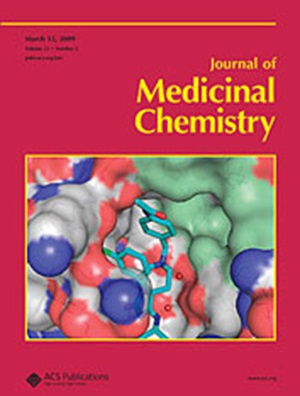一类新的食欲素2受体激动剂作为治疗发作性睡的潜在药物的发现
IF 6.8
1区 医学
Q1 CHEMISTRY, MEDICINAL
引用次数: 0
摘要
食欲能系统从外侧下丘脑伸出,通过两个受体,即食欲素受体1型(OX1)和食欲素受体2型(OX2)起作用,主要通过OX2来稳定清醒。1型嗜睡症(NT1)的特征是过度嗜睡和猝厥,并与产生食欲素的神经元的丧失有关。目前的治疗方法控制了症状,但没有解决疾病的根本原因。例如,精神兴奋剂(如莫达非尼)可减少白天过度嗜睡(EDS),而氧化钠(γ氨基丁酸受体激动剂)可减少EDS和猝倒。尽管经过几十年的研究,还没有一种小分子的OX2激动剂进入市场。这项研究提出了两种新的脑渗透,口服生物可利用的OX2激动剂与苯基甘氨酸样支架的发现。在NT1小鼠模型中,这些化合物稳定了清醒并减少了猝倒。在健康的狗身上,他们增加了清醒的时间。这些结果突出了它们作为治疗嗜睡症和其他类型嗜睡症的潜力。本文章由计算机程序翻译,如有差异,请以英文原文为准。

Discovery of a New Class of Orexin 2 Receptor Agonists as a Potential Treatment for Narcolepsy
The orexinergic system, projecting from the lateral hypothalamus, operates through two receptors, orexin receptor type-1 (OX1) and orexin receptor type-2 (OX2), stabilizing wakefulness, mainly via OX2. Narcolepsy Type 1 (NT1) is characterized by excessive sleepiness and cataplexy, and is linked to a loss of orexin-producing neurons. Current therapies manage the symptoms but do not address the underlying cause of the disease. For example, psychostimulants (e.g., modafinil) reduce excessive daytime sleepiness (EDS) and sodium oxybate (gammaaminobutyric acid receptor agonist) reduces both EDS and cataplexy. Despite decades of research, no small-molecule OX2 agonist has reached the market. This study presents the discovery of two new brain-penetrant, orally bioavailable OX2 agonists with a phenylglycine-like scaffold. These compounds stabilized wakefulness and reduced cataplexy in a mouse model of NT1. In healthy dogs, they increased time in wakefulness. These results highlight their potential as treatment for narcolepsy and other types of hypersomnolence.
求助全文
通过发布文献求助,成功后即可免费获取论文全文。
去求助
来源期刊

Journal of Medicinal Chemistry
医学-医药化学
CiteScore
4.00
自引率
11.00%
发文量
804
审稿时长
1.9 months
期刊介绍:
The Journal of Medicinal Chemistry is a prestigious biweekly peer-reviewed publication that focuses on the multifaceted field of medicinal chemistry. Since its inception in 1959 as the Journal of Medicinal and Pharmaceutical Chemistry, it has evolved to become a cornerstone in the dissemination of research findings related to the design, synthesis, and development of therapeutic agents.
The Journal of Medicinal Chemistry is recognized for its significant impact in the scientific community, as evidenced by its 2022 impact factor of 7.3. This metric reflects the journal's influence and the importance of its content in shaping the future of drug discovery and development. The journal serves as a vital resource for chemists, pharmacologists, and other researchers interested in the molecular mechanisms of drug action and the optimization of therapeutic compounds.
 求助内容:
求助内容: 应助结果提醒方式:
应助结果提醒方式:


